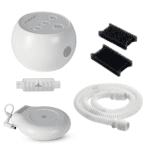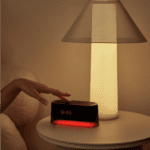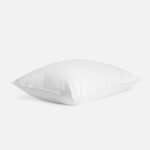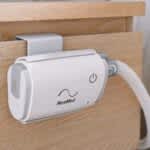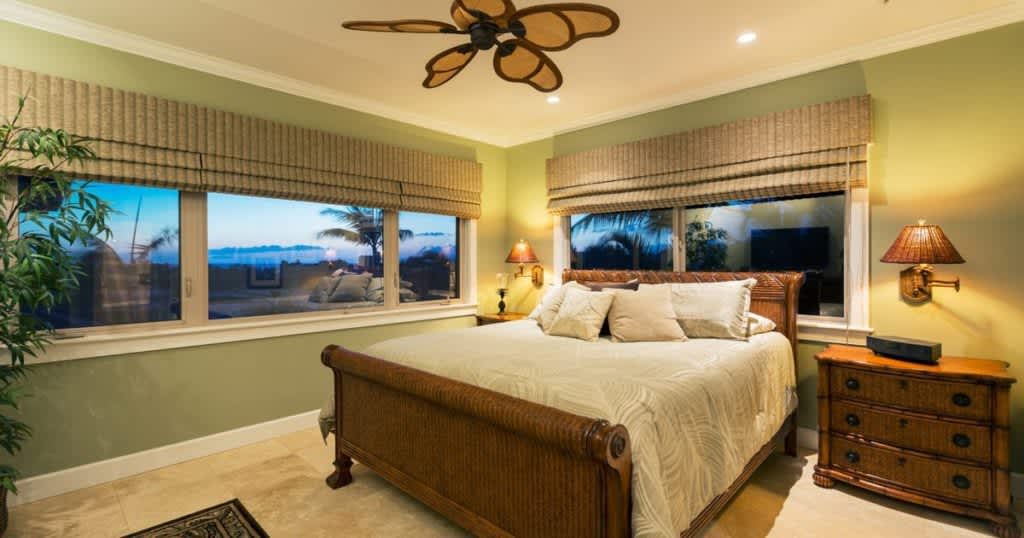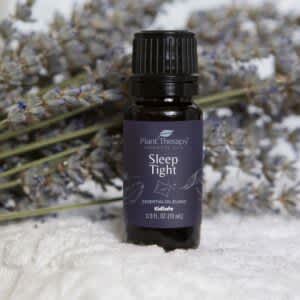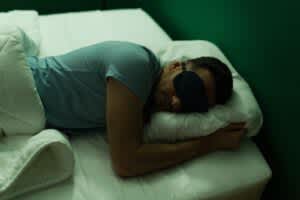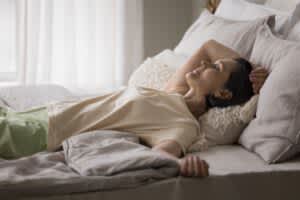As part of the optimal sleep environment, experts recommend keeping the bedroom quiet, cool, and dark. In addition to investing in a fan or black out curtains, some experts believe that certain colors in the bedroom can promote healthy sleep.
When deciding what color you should paint your bedroom, it may be tempting to simply choose your favorite color. However, research suggests that different hues may lead to different physical and emotional responses. These responses may vary from person to person, but there may also be trends.
Many people associate color with states of weather and objects, which can affect their response to those colors. Some may also have cultural or emotional associations with certain colors. One study found rooms painted in warm colors were described by participants as exciting and stimulating, while rooms painted in cool colors were seen as spacious and restful. These color associations have the potential to influence mindset at bedtime. As a result, the colors you see before you close your eyes may impact how fast you fall asleep and how well you sleep.
Personal experiences can change how each person responds to certain colors, and some people may find bedroom colors have no effect on their sleep. However, the colors in the table below have been linked to positive physical and emotional effects that may positively impact sleep for many people.
Color | How It Affects Sleep |
|---|---|
Blue | Calms the nervous system |
Green | Reduces stress |
White | Minimizes distraction and allows you to relax |
Beige | Creates balance and limits distraction |
Pink | May lower blood pressure |
Blue
The color blue has many positive associations, including clear skies or clean, clear water. According to color psychology, soft blues can help calm the mind, while more intense blues can inspire reflection and clear thoughts.
A study of university residence hall room colors found that blue was the most preferred room color. The students in the study reported that blue best encouraged studying. Additionally, the students highly associated the color blue with a calm mood.
In a study of physical and emotional experiences in colored rooms, researchers found that a blue room was less likely to put the brain in an excited state compared with a red room. Other research found that a blue study environment induced feelings of calmness and relaxation, which are important for sleep.
The color blue can be incorporated into your bedroom in a number of ways. You might paint your walls blue or choose a blue accent wall. You can also choose blue bedding, furniture, rugs, or art to create an environment that soothes you. As blue comes in many different shades, it is a good color for layering across decorative pillows, throw rugs, or other accessories.
Green
Like blue, green is another cool, calming color. Green can make a space feel peaceful, given that this color is associated with grass, trees, and other plants found in nature. These peaceful associations can help you de-stress and relax into a night of restful sleep.
In the previously mentioned study on university housing, green was the second most preferred room color. However, certain shades of green may be more desirable for sleep than others. For example, yellow-greens may be less desirable because of negative associations with rotten food.
Soft shades such as mint green or sage might be calming colors for a bedroom. You can also incorporate green in other ways, such as hanging green art on walls or green curtains over your window. You can also bring green plants into your room. Indoor plants can both purify the air and reduce stress levels.
White
White is a neutral shade that inspires happiness and relaxation. Studies in the U.S. have found that the color white is strongly associated with positive emotions and images, such as fluffy clouds. In office spaces, white has been reported as one of the least distracting wall colors. Incorporating white in your sleep space can minimize distraction and help you relax before falling asleep.
White is a common ceiling color. A white ceiling can make the room feel more spacious. In the study of university rooms, students vastly preferred a white ceiling to a colored ceiling. Having lighter-colored walls in addition to a white ceiling may further increase the sense of spaciousness.
Apart from the walls, another way to incorporate white into your bedroom is to pair it with an accent color. For example, you might choose a blue or green color for one wall, and paint the remaining walls white or shades of off-white. That way you can have a pop of color without it overwhelming the room and being a distraction when you fall asleep.
Beige
Beige is another neutral color that allows for calm and balance in a room. Like white, beige is a popular color for workplace walls because it is seen as less distracting than brighter colors. Painting your bedroom walls beige walls can create a distraction-free space, making it easier for you to fall asleep.
Because of its lightness, beige balances well with other colors, even if they are more vivid hues. Beige works well as both a neutral wall color and an accent color. You can easily incorporate beige into your room decor, bedding, and wall art.
Pink
Like white, pink is a bright color commonly associated with positivity. However, the research on the exact effects of pink walls on the brain has differed over the past several decades. This may be partially due to some cultures associating pink with femininity.
In the late 1970s, pink walls in prisons were thought to reduce aggression in inmates. More recently, lighter pink walls in prison settings were demonstrated to reduce aggression and lower blood pressure. However, further studies have failed to reach the same conclusion and more high-quality academic research is needed.
Some shades of pink may be better suited for a bedroom than others. The latest prison experiment used a soft pink, as some people find a hot pink too vivid and distracting. If you want a more vivid pink in your sleeping space, consider only having one accent wall in the color or incorporating it into your bedding and wall decor.
Best Bedroom Colors for Children
Preferences and responses to color shift through infancy, childhood, and adulthood. Although infants match adults in their preference for blue hues over green-yellow hues, infants seem to be more interested in saturated colors than less vivid colors. Individual responses to color may be further shaped throughout childhood with exposure to loved or hated objects in specific colors.
Research shows that children also display positive responses to bright colors such as red, yellow, pink, green, blue, or purple over dark colors like gray, black, and brown. While adults also appreciate standalone bright colors, they tend to prefer lighter colors for wall color. By contrast, warmer or brighter colors may help a bedroom space feel inviting and comfortable for children.
- Orange: Orange is typically disliked by American adults, perhaps due to its harshness and negative associations with traffic signs. However, the color orange is also associated with joy and happiness. As dark orange is not very popular, a medium or light orange hue may be most appropriate for a child’s bedroom.
- Yellow: Children associate the color yellow with happiness, and yellow has been found to reduce anxiety for children attending a dentist appointment. Light yellows may bring warmth into a child’s bedroom without being too distracting or overwhelming.
- Pink: Pink is a popular bedroom color choice for children because it evokes positive emotions. Some children may find the color calming.There may also be gender preferences for the color pink, due to the fact that parents often choose pink for a girl’s room and blue for a boy’s room.
- Brown: Children who are sensitive to overstimulation may prefer a bedroom with more brown, which can be perceived as calming. Light brown and beige can also be paired with brighter colors to create balance.
- Green: One study found that children in a hospital setting preferred their bedroom to be blue or green. The color green is associated with quietness and many adults find it comforting. Painting a child’s bedroom walls green can make the environment calm and suitable for comfortable sleep.
Worst Bedroom Colors for Children
Both adults and children tend to associate dark colors with negative emotions. If these feelings lead to stress, anxiety, or restlessness before bedtime, children may struggle to fall asleep or have disturbed sleep.
- Red: Research shows that red is a stimulating color for adults, leading to the possibility this is true for children as well. Research has shown children associate the color red with negativity. This association may affect their mindset before bedtime and make falling asleep a challenge.
- Yellow: Although yellow has many positive associations, some children may find bright yellows to be overwhelming or distracting, which can make it more difficult to fall asleep.
- Gray: Children tend to have negative associations with dark colors, including gray. If gray evokes negative emotions for your child, they may have trouble relaxing at bedtime.
What Color Light Helps You Sleep?
Light is known to impact sleep quality. For bedroom lighting, experts recommend low color temperature lights in warm hues such as red, orange, and yellow. This is the opposite of the cool greens and blues recommended for wall hues.
Exposure to white and blue light, or high color temperature light, is the strongest visual cue for suppressing the release of melatonin, the sleep hormone. Bright light exposure before bedtime has been shown to suppress melatonin production in the body, particularly in children.
In a study comparing different light temperature environments, children were significantly less sleepy in the room with bluer lighting. By contrast, some studies have shown that lighting with a color temperature similar to candlelight is less likely to suppress melatonin. As a result, using this type of lighting in the bedroom can improve your quality of sleep.
One small study compared how well adults slept in environments with different color illumination. Participants fell asleep much faster in their preferred color illumination than in any other space, possibly because they found it more relaxing.
How Does Blue Light Affect Sleep?
Blue light is an important part of regulating the body’s circadian rhythm, a primary contributor to the sleep-wake cycle. With exposure to blue light during the day, the sleep hormone melatonin is suppressed. This means that exposure to blue light helps keep people alert and able to complete daily tasks.
While blue is a highly recommended bedroom wall color because it invokes calm and relaxation, exposure to blue light in the evening can negatively impact sleep. Blue light is emitted from electronic devices such as TVs, computers, and cell phones. Research shows that using these devices right before bedtime delays sleep onset. Excess exposure to blue light at night can also increase sleepiness the next morning because it disrupts the circadian rhythm.
Worst Bedroom Colors
Colors with negative associations or stimulating physical effects are typically not recommended for primary bedroom colors. Having excessive amounts of these colors in your bedroom can make winding down at the end of the day more difficult and delay or disrupt your sleep.
Color | How It Affects Sleep |
|---|---|
Red | Stimulates energy and aggression |
Purple | May lead to vivid dreams or nightmares |
Dark Brown | Associated with negativity |
Black and Gray | Can feel cold and suppressive |
Red
Red is often associated with aggression and danger. Researchers theorize that because the human eye has the most trouble adjusting to see the red wavelength, people may perceive red objects to be closer than they are. The color also comes with a number of negative associations like blood, which might make a red-colored sleeping environment less than comfortable.
Physiologically, red is thought to be a stimulating color. One study found that people in a red room experienced more brain waves associated with an alert, awake state. Other studies have found that the color red increases heart rate and blood pressure. One study found that seeing the color red increased the physical force participants used on a task when compared to blue and gray. Red may even trigger a fight-or-flight response. Such arousal can be overstimulating or anxiety-provoking and make it difficult for you to fall asleep.
When designing your bedroom, consider limiting the use of red to a few items at most. You can also consider using a less saturated shade of red so the color is not as harsh. Pink, which is related to red, may offer warmth without the negative associations and arousing physiological response.
Purple
Although purple is a shorter wavelength color like green and blue, it is perceived as more distracting. Some believe that a purple room can lead to more nightmares.
According to a Travelodge study of 2,000 British sleepers, people who sleep in purple rooms get an average of fewer than six hours of sleep each night, the lowest amount reported of any color in that study.
Instead of using purple in your room decor, consider the closely related color violet, which does not have the strong red undertones of purple. In the study of university housing, violet was the third-ranked choice for room color after blue and green. The same study found that violet was considered calmer than red, yellow, and orange.
Dark Brown
Because it is a dark color, brown tends to be associated with negative emotions. The color may also be disliked because it is associated with unpleasant images. A brown bedroom may be perceived as cold. In the Travelodge study, people with brown bedrooms only got an average of six hours and five minutes of sleep each night.
To avoid unpleasantness linked to dark brown, limit the color to room furniture, baseboards, and trim. Rather than painting your walls dark brown, consider using beige. The color beige can offer more warmth and light in a room.
Black and Gray
Even though an ideal sleep environment is dark, too much black or gray color in your bedroom may negatively impact your sleep. Black is often linked to coldness and negative emotions. Gray, the color of cloudy and stormy days, may be seen as suppressive and was the least favorite color used to paint a students’ union complex in one study. Because of these negative associations, black and gray bedrooms may make it difficult to relax and fall asleep or sleep peacefully.
For those who want to incorporate black and gray into the bedroom, there are a number of ways to do so without overwhelming the space. Both black and gray can be used as an accent color in the furniture, woodwork, or molding in the bedroom.
If you want to paint your walls gray, consider lighter shades of gray for a better sense of spaciousness. When paired with a cool color such as blue or green, light gray may feel more relaxing. You might also choose a gray paint with blue, green, or violet undertones. These undertones may make the room feel less dreary than a dark gray or black color palette. As for black, it may be best to stick with smaller objects such as picture frames.
Tips for Choosing the Best Color for Your Bedroom
- Try a matte paint finish: A flat or matte paint finish absorbs light. In contrast, a wall with a glossy finish tends to reflect light, which can be distracting as you try to fall asleep.
- Think about the lighting: Before settling on a color, see how it is affected by the lighting in your room. Test the color in your bedroom’s natural lighting, artificial lighting, and in the darkness level you keep the room at when you sleep. You might also consider having a brighter overhead light for daytime and a warmer-hued bedside lamp for the evening.
- Consider your preferences: If you find a certain color calming and relaxing, even if it is not a commonly relaxing hue, it may be the right choice for your walls.
Additional Tips to Optimize Your Bedroom for Sleep
- Bedding: The combination of wall color, lighting, and bedding color can change the appearance of your room. For example, if your walls are dark, using lighter-colored bedding may make your bedroom feel brighter and larger.
- Furniture: Aim for furniture that makes your sleep space functional and stress-free. Clutter can reduce feelings of well-being and negatively impact sleep, so consider underbed storage or baskets to reduce the number of items on your floor.
- Rugs: Floor rugs in the bedroom can reduce noise if a sleep partner or pet gets up during the night. Rugs also provide an additional opportunity to add color to your bedroom.
- Curtains: To fall asleep more easily and not wake too early, it is important to eliminate excess light. Heavy, dark curtains can block out street lights or an early sunrise.
Resources for Bedroom Environment and Sleep
- How to Design Your Bedroom for a Better Night’s Sleep: The layout of your bedroom can impact your sleep. Forbes breaks down which layouts are most popular among people who get restful sleep.
- How to Light a Modern Bedroom: The right lighting for your bedroom depends on a number of factors. This blog post from YLighting covers everything from functional lighting placement to bulb color.
- Picking the Best Bedroom Rug: Rugs can enhance your bedroom and reduce noise. This blog offers recommendations for choosing a rug that meets your needs based on sizing, texture, and design.
- How to Choose the Best Curtains for Your Bedroom: Bedroom curtains do more than just blocking out light. Strategies for choosing curtain height, fabric, and hardware are all explained on the Martha Stewart blog.
- Bedroom Discussions: Houzz.com connects people who are interested in renovating their homes. The Bedroom Discussions forums offer a place to post questions and access design advice from other members.
References
Ask the Sleep Doctor
Have questions about sleep? Submit them here! We use your questions to help us decide topics for articles, videos, and newsletters. We try to answer as many questions as possible. You can also send us an email. Please note, we cannot provide specific medical advice, and always recommend you contact your doctor for any medical matters.


